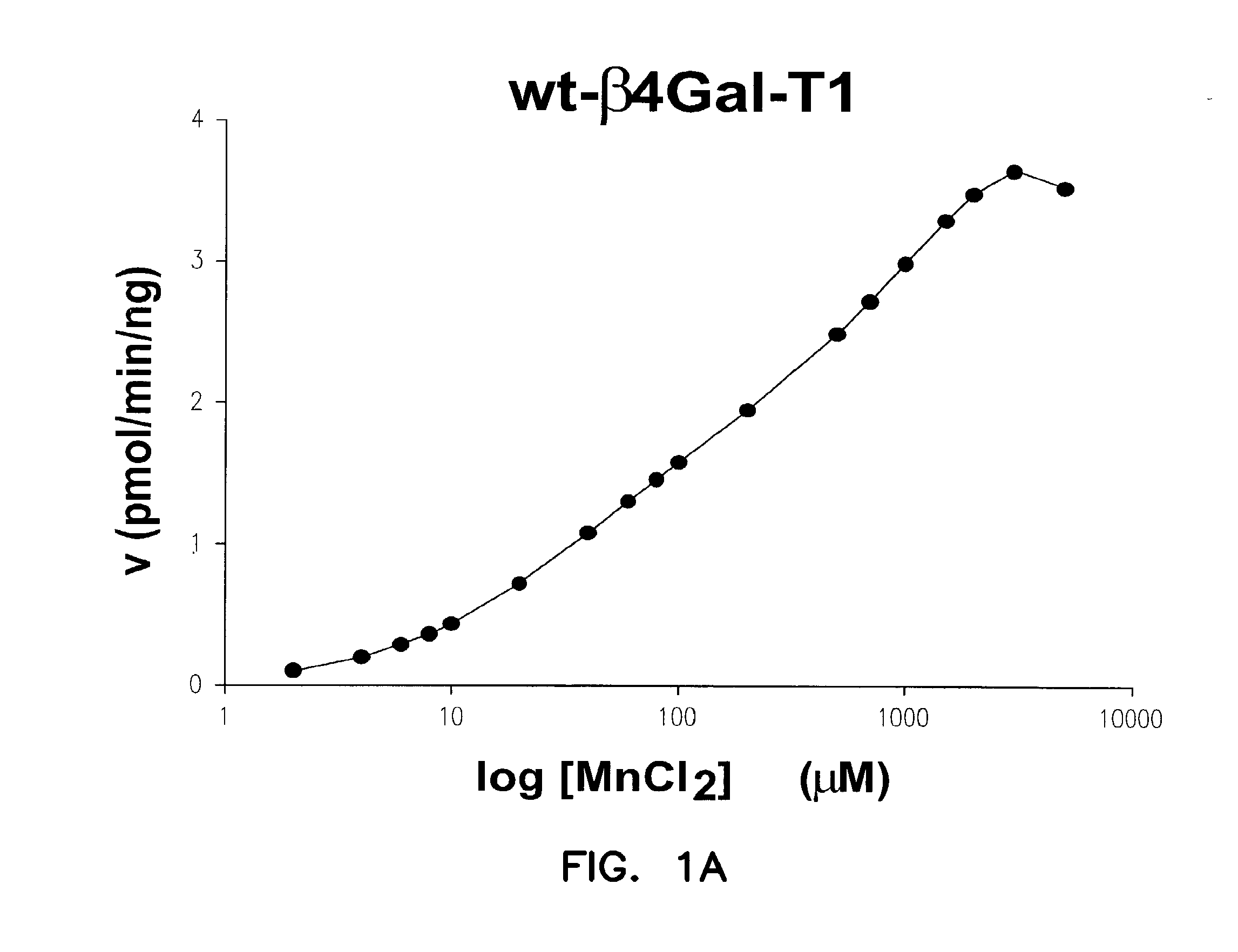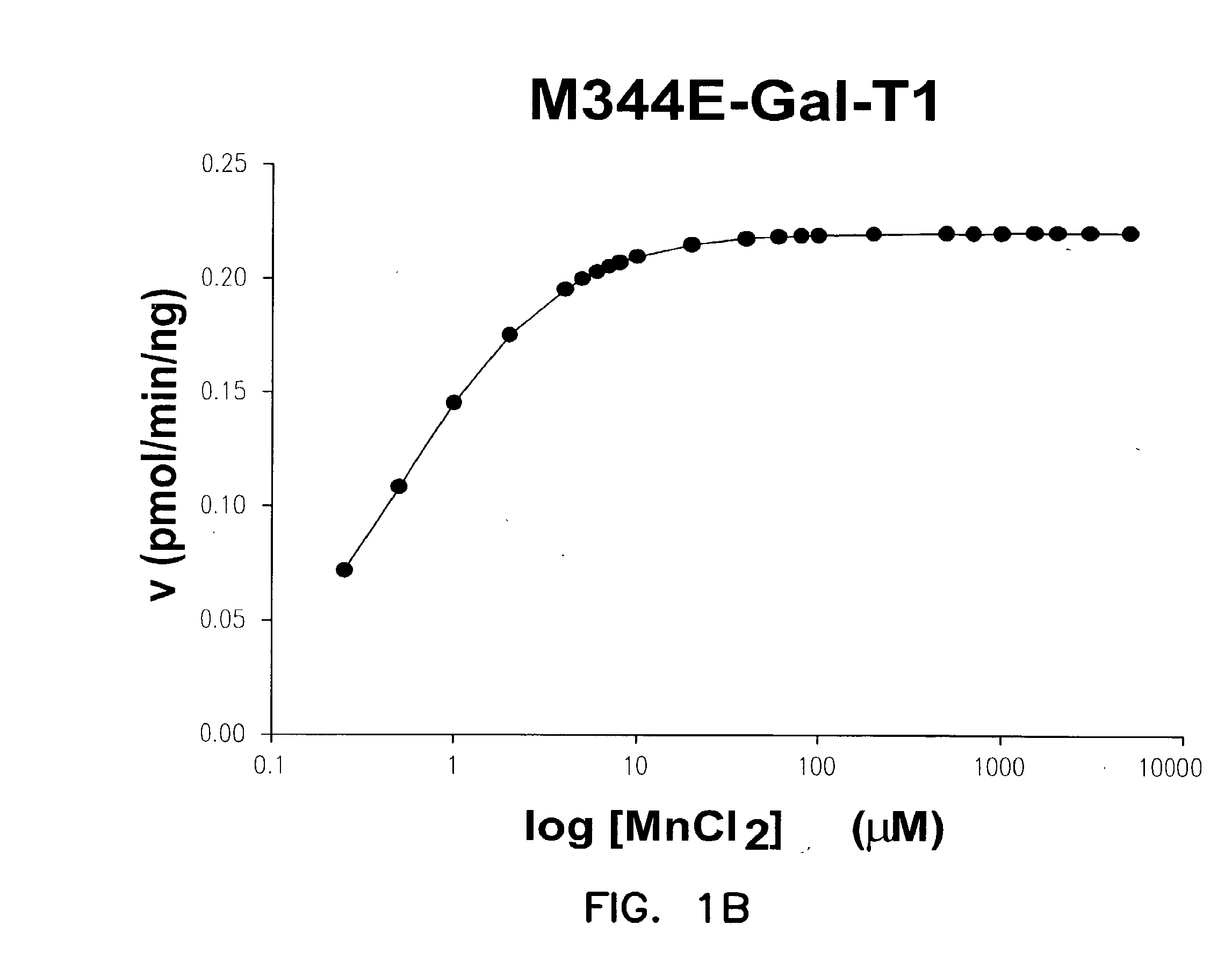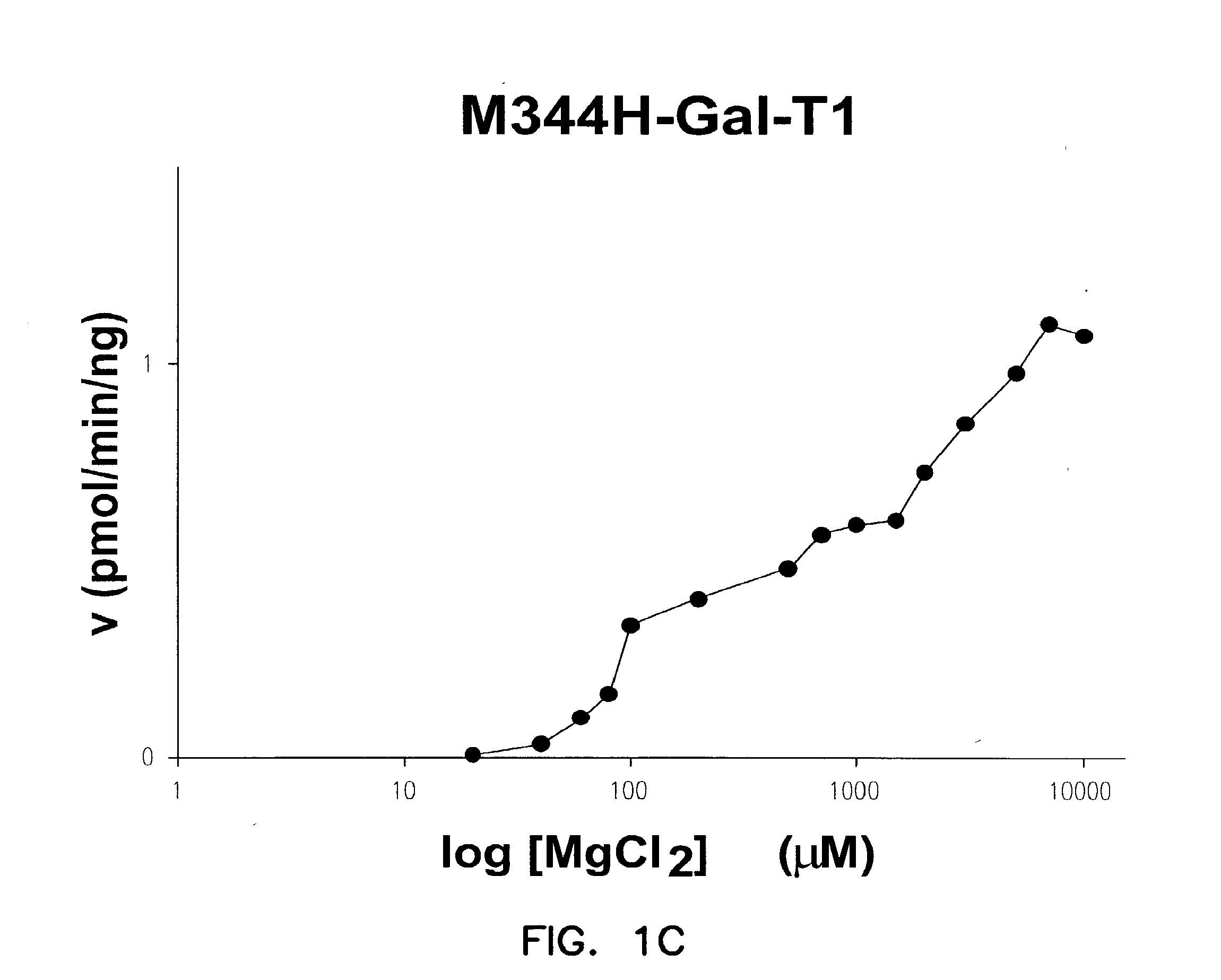Catalytic domains of beta(1,4)-galactosyltransferase i having altered metal ion specificity
a catalytic domain and beta(1,4)-galactosyltransferase technology, applied in the field of (1, 4)galactosyltransferase i mutants having altered metal ion specificity, can solve the problems of relatively little effort to test oligosaccharides as therapeutic agents, no generally applicable synthetic techniques for synthesizing oligosaccharides are available, and the least studied oligosaccharides
- Summary
- Abstract
- Description
- Claims
- Application Information
AI Technical Summary
Benefits of technology
Problems solved by technology
Method used
Image
Examples
example 1
Site-Directed Mutagenesis
[0133]Site-directed mutagenesis was performed using the polymerase chain reaction (PCR) method. Construction of the mutants was done using plasmid pEGT-d129 as the template. The pEGT-d129 plasmid contains a BamH I / EcoR I fragment inserted into a pET23a (Novagen, Madison, Wis.) vector that codes for residues 130 to 402 of bovine Gal-T1 (Boeggeman et al., Protein Eng., 6:779 (1993)), and has a Cysteine to Threonine exchange at the 342 amino acid residue position (C342T).
[0134]The nucleic acid sequences of the primers corresponding to the upper DNA strand that were used to create the M344H and M344E mutations are: M344H: 5′ATCGGGAAGACGCGTATCCGCCACTCGAGAGAC-3′ (SEQ ID NO: 12), and
M344E:5′ATCGGGAAGACGCGTATCCGCCACTCGAGAGAC-3′ (SEQ ID NO: 13). The restriction site Mlu I is underlined and the mutation codon in bold italics. Typically, the Gal-T1 DNA fragment between Mlu I to EcoR I was PCR-amplified using the terminal cloning primer and the mutagenesis primer. The f...
example 2
Protein Expression and Purification
[0136]For protein expression BL21 (ADE3) / pLysS-competent cells were transformed with the pET vector derivatives according to the manufacturer's protocols. The transformed cells were grown in LB broth containing 50 ng / ml−1 ampicillin to an OD600 nm of about 0.7, followed by induction with 0.4 mM IPTG. Cultures were harvested after 3-4 hours by centrifugation at 2000×g for 20 minutes. The inclusion bodies were isolated and solubilized as described (Boeggeman et al., Protein Eng., 6:779-785 (1993)). From a liter of induced bacterial culture, the yield is generally 80 to 100 mg of purified inclusion bodies. Novex gels were used for SDS-PAGE analysis and the protein bands were visualized with Coomassie blue. Protein concentrations were measured with the Bio-Rad protein dye reagent with bovine serum albumin as the standard.
[0137]An S-sulfanation protocol was used for folding the protein obtained from the inclusion bodies (Boeggeman et al., Protein Eng., ...
example 3
J34Gal-T Enzyme Assays
[0138]Protein concentrations were measured using the Bio-Rad Protein Assay kit, based on the method of Bradford and further verified on SDS-PAGE gels using standard protein concentration markers. An in vitro assay procedure for Gal-T1 has been reported previously (Ramakrishnan et al., J. Mol. Biol., 310:205 (2001)). The activities were measured using UDP-Gal as sugar nucleotide donor, and GlcNAc as the acceptor sugar. For the specific activity measurements, a 100 μl incubation mixture containing 25 mM GlcNAc, 5 mM MnC2 or MgCl2, 20 mM Tris-HCl pH 8.0, 500 μM UDP-Gal, 500 ng M344H-Gal-T1 or 30 ng of C342T-Gal-T1 and 0.5 μCi 3H-UDP-Gal was used for each Gal-T reaction. The incubation was carried out at 30° C. for 15 minutes. The reaction was terminated by adding of 200 μl cold water, and the mixture was passed through a 0.5 mL bed volume column of AG 1-X8 cat ion resin (Bio-Rad) to remove any unreacted 3H-UDP-Gal. The column was washed successively with 300, 400 ...
PUM
| Property | Measurement | Unit |
|---|---|---|
| pH | aaaaa | aaaaa |
| concentration | aaaaa | aaaaa |
| concentration | aaaaa | aaaaa |
Abstract
Description
Claims
Application Information
 Login to View More
Login to View More - R&D
- Intellectual Property
- Life Sciences
- Materials
- Tech Scout
- Unparalleled Data Quality
- Higher Quality Content
- 60% Fewer Hallucinations
Browse by: Latest US Patents, China's latest patents, Technical Efficacy Thesaurus, Application Domain, Technology Topic, Popular Technical Reports.
© 2025 PatSnap. All rights reserved.Legal|Privacy policy|Modern Slavery Act Transparency Statement|Sitemap|About US| Contact US: help@patsnap.com



